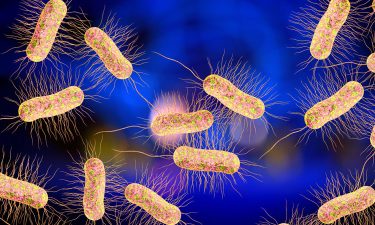
A new lot of USP Reference Endotoxin Standard (RSE) was formulated and filled in 2023 and is currently undergoing calibration. This lot represents the final aliquot of a large (31-gram) bulk of E. coli 0113:H110K(-) lipopolysaccharide (LPS) prepared under stringent laboratory conditions in 1974 by Rudbach and co-workers.1 The depletion of this large bulk provides an opportunity to prepare a user requirements document for a new standard that will a) revisit assumptions made by experts in 1974, b) assess practical knowledge and experience gained in the last 50 years of using the Rudbach preparation, c) recognise and incorporate knowledge gained from current research on microbial adaptation and LPS chemistry, and d) consider the appropriateness of the standard for non-calibration uses.
About endotoxins
Endotoxins are structural components of the outer leaflets of the outer membranes of most Gram-negative bacteria. The biological activity of endotoxin is derived from lipopolysaccharide (LPS), an amphipathic molecule that is integral to the outer membrane and provides an essential permeability barrier for the cell. LPS has a biologically active hydrophobic Lipid A moiety that is buried in the membrane, a core oligosaccharide, and a hydrophilic repeating polysaccharide portion (O-antigen) that extends into the extracellular environment. Lipid A is a negatively charged, bis-phosphorylated glucosamine disaccharide, typically with 4-7 acyl chains.2 Although this basic LPS architecture is generally conserved, the number and length of acyl chains and degree of phoshorylation can vary greatly depending on the genus and species of organism and the culture conditions. In nature, this variability results in a highly heterogeneous population of LPS chemistries within a cell or culture.2-4
Gram-negative microorganisms are resilient to environmental change and stress, and have evolved an ability to alter the chemistries of their LPS in several ways to assure membrane stability. One such mechanism is the two-component system (TCS). For example, the PhoP/PhoQ TCS senses and responds to a lowered divalent cation concentration in the environment needed to neutralise Lipid A charge and assure membrane stability. Two-component systems ‘decorate’ or ‘remodel’ the negatively charged phosphate groups on Lipid A by adding positively charged 4-amino-4-deoxy-L-arabinose (L-Ara4N) and phosphoethanolamine (pEtN), thereby restoring neutrality and membrane stability.2-4
In nature, membrane-bound LPS is released from the cell by the production of nonviable outer membrane vesicles (OMV), produced and shed as a part of the normal growth and stress management cycles of the organism. Therefore, ‘natural’ LPS is not only likely to be adapted and decorated but is also surrounded by outer membrane phospholipids and proteins such as porin that are present in the parent cell.3,4
Reference standard endotoxins
In 1974, Rudbach and co-workers prepared a new US national standard to meet US Food and Drug Administration’s (FDA’s) stated purpose: calibration of the “new” and highly variable limulus amebocyte lysate (LAL) gel clot reagents.1 Rudbach’s lab prepared a 31-gram batch of “refined and purified” LPS using a hot phenol (Westphal) extraction method followed by alcohol precipitation and other refinements prior to aliquoting and lyophilisation. These aliquots have since been formulated as needed with polyethylene glycol and lactose5 and are universally referenced as reference standards by the major pharmacopeias as well as the World Health Organization (WHO).
Although intended for sole use as a calibrant, the similarly prepared RSE and secondary E. coli standards have been used for test method suitability studies and routine positive product controls (PPC).
In 1982, Firca and Rudbach described the reasoning behind the choice of microorganism as well as properties and preparation of the 1974 LPS bulk.6 Their presentation states that they hoped their information “might form the basis for future discussions on desirable properties for other reference standard endotoxins which might be prepared.” They identified two major goals for the 1974 effort.
“The targeted chemical goal was to prepare a lipopolysaccharide that was free of potentially biologically active proteins, peptides, polynucleotides or polysaccharides.”
Rudbach recognised that a highly purified preparation of LPS would be inappropriate given its intended use as a calibrant for a biological assay. Highly purified Lipid A preparations had low biological activity, poor solubility and poor stability – all undesirable qualities for a calibration analyte. Therefore, the decision was made to provide a “refined and purified”6 calibrant for FDA that was relatively free of potentially biologically active peptides, polynucleotides and polysaccharides, and that could affect a biological assay. E. coli 0113:H110K(-), a laboratory construct, was chosen for its genotypic and phenotypic characteristics: 1) it was devoid of immunodominant sugars, and 2) it was incapable of producing a capsular polysaccharide that might otherwise contaminate the final extracted preparation.
Why was E. coli considered a typical RSE?
- LAL had initially been proposed as a clinical diagnostic for septicaemia and endotoxaemia, two conditions often associated with E. coli
- This strain had been used previously for its LPS and was known to be stable under average storage conditions when maintained as a lyophilised bulk
- Experiments examining the rates of LAL reactions of seventeen different LPS preparations using a very early kinetic turbidimetric platform demonstrated that E. coli 0113:H10k(-) ranked eighth of the seventeen. The authors felt that this ranking confirmed the choice of E. coli as “typical”.
In the same year, Tsang and co-workers published data on the degradative effects of hot phenol extraction on LPS, demonstrating that the method affected not only the O-antigen, but also ester-bound fatty acids, resulting in a heterogeneous mixture of partially purified LPS and degradation products.7 Their data suggest that in addition to the natural heterogeneity in LPS chemistry, the Westphal extraction introduced additional heterogeneity via method artifacts.
The second goal was to “produce a reference standard of a “typical” endotoxin with an average biological potency.” E. coli was and is a well-known Gram-negative microorganism but why was it considered typical?
Moving towards a new standard
Fifty years later, we recognise that although the standard was intended to be prepared from a “typical” Gram-negative organism, it was never intended to be representative of or “worst case” regarding pharmaceutical contaminants which are more typically unrefined, decorated, largely hepta-acylated endotoxins from non-fermenters.
While a “purified” E. coli LPS laboratory construct might be useful for BET calibration purposes, it is not a surrogate for contaminating endotoxins, which are a) complexed with other membrane components, and b) often hepta-acylated LPS from non-fermenting Pseudomads or related organisms, and c) almost assured to contain “decorated” LPS as a result of their adaptation to harsh pharmaceutical environments. The authors offer two pathways for approaching a new standard:
Consider two preparations: one for strict use as an assay calibrant, and one to use as a more typical surrogate for natural contamination in non-calibration laboratory studies.
- Use of a “refined and purified” E. coli standard will maintain the 50-year continuity for assay calibration
- A typically hepta-acylated, decorated “refined and purified” biological or an OMV standard derived from an organism likely to be found in pharmaceutical manufacturing would be available as an experimental analyte. This standard would be prepared under conditions that mimic the stresses of a pharmaceutical environment to optimise decorations. It will be standardised against the calibration analyte.
Consider one “refined and purified” standard from an organism that is likely to be found as a contaminant, prepared under conditions that mimic stresses in pharmaceutical environments, again, to optimise Lipid A decorations. This standard would be far more representative of the chemistry of LPS in endotoxins found as contaminants in pharmaceutical products, and therefore would be more “typical” for use both as a calibrant and an analyte for assessing the true effects of hold times and depyrogenation.
Standard(s) should be readily available, reasonably priced, and prepared in large enough quantities to avoid supply chain concerns. The microorganisms that serve as a source for these LPS preparations should be well characterised, deemed fit for purpose, and stored in a manner that will assure genetic stability and availability for future preparations.
With the depletion of the 1974 LPS preparation, we are in a unique position to understand decisions made 50 years ago and write a user specification for the new standard that will reflect not only the pragmatic issues of “typical” contamination but also acknowledges the significant body of scientific knowledge that has been produced on microorganism adaptation and its relation to LPS chemistry.
About the authors
 Radhakrishna S Tirumalai, PhD
Radhakrishna S Tirumalai, PhD
Dr Tirumalai is currently Senior Principal Scientist at Merck Research Laboratories (MRL), Center for Excellence in Microbiology. He was at the USP during 2003-2022 as the Liaison to the Expert Committee on Microbiology. Radhakrishna represented USP on PDA expert task forces and committees related to microbiology, the organising committee of PDA Global Microbiology Conference 2006-2018, on AAMI expert working groups 2004-2022, and the editorial board of FDA’s Pharmaceutical Microbiology Manual. He is a frequent speaker globally and has authored numerous publications, review articles and book chapters.
 Karen Zink McCullough, MS
Karen Zink McCullough, MS
Karen is Managing Member at MMI Associates, LLC, a consulting company focusing on the pharmaceutical industry. She is a widely recognised expert in pharmaceutical microbiology, most notably the Bacterial Endotoxins Test, and has published extensively on the subject. Karen has held a number of executive positions in the pharmaceutical and In Vitro Diagnostics industries including Vice President of Quality Operations, Sr Director of Quality Compliance and Director of Microbiology.
References
- Rudbach JA, Akiya FI, Elin RJ, et al. 1974. Preparation and Properties of a National Reference Standard. Clin Microbiol. 3(1): 21-25
- Dardelle F, Phelip C, Darabi M, et al. Diversity, Complexity, and Specificity of Bacterial Lipopolysaccharide (LPS) Structures Impacting Their Detection and Quantification. International Journal of Molecular Sciences [Internet]. 2024 Mar 31 [cited 2024 Jun 7];25(7):3927. Available from: https://pubmed.ncbi.nlm.nih.gov/38612737/
- Simpson BW, Trent S. 2019. Pushing the envelope: LPS modifications and their consequences. Nat Rev Microbiol. 17(7): 403-416
- Bonnington KE, Kuehn MJ. 2016. Outer Membrane Vesicle Production Facilitates LPS Remodeling and Outer Membrane Maintenance in Salmonella during Environmental Transitions. mBio. 7(5). ?
- Poole SP, Dawson P, Gaines Das RE. 1997. Second international standard for endotoxin: calibration in an international collaborative study. Endotoxin Research 4(3): 221-231.
- Firca JR, Rudbach JA. 1982. Reference Endotoxin: A Practical Rationale. In: Endotoxins and Their Detection With the Limulus Lysate Test. Watson, Levin, Novitsky, editors. Pages 121-130. Alan R. Liss, New York.
- Tsang JC, Wang CS, Alaupovic P. 1974. Degradative Effect of Phenol on Endotoxin and Lipopolysaccharide Preparations from Serratia marcescens. Bacteriol. 117(2): 786-795.
The post Endotoxin standards: reflection and recommendation appeared first on European Pharmaceutical Review.

